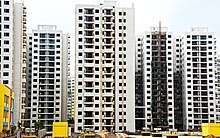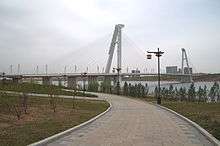Under-occupied developments in China
Under-occupied developments in China are mostly unoccupied property developments in China, and commonly referred to as "ghost cities"[1] or "ghost towns".[2] The phenomenon was observed and recorded as early as 2006 by writer Wade Shepard, and subsequently reported by news media over the decades, often cast in a negative light. News stories around the topic have been criticized as hasty judgments.[3][4]
Terminology
Media outlets often label under-occupied development areas in China as ghost cities or ghost towns.[1][5] However, the two terms are technically misnomers since the term "ghost town" describes places that previously had economic activity but have since become defunct and abandoned, while many under-occupied developments in China are new installations that have yet to receive resident immigration.[6][7]
Additionally, some reported cases of ghost cities are not in and of themselves administrative entities but instead districts built in the suburban region of functioning cities to provide accommodation for a growing urban population.[8]
Background


The way in which property values are structured in China plays a role in the creation of "ghost cities", according to author Wade Shepard, who has traveled widely to research the phenomenon of China's underoccupied cities. "Economically affordable housing" must be lived in by the owner, and can not be bought and sold as an investment. The developer is only permitted to sell "economically affordable housing" at 5% over the cost of construction. By contrast, "commodity housing" can be bought and sold as an investment. Because housing is a physical object, and China's large population guarantees an ongoing demand for housing, commodity housing is considered a more secure way to store money. Except in some Tier 3 and Tier 4 cities, which have different government regulations, "commodity housing" generally sells as an investment.[4] In addition, these homes typically serve as future homes for the buyer's offspring to live in when they get married.[9]
Construction of "commodity housing" is driven by the disparity between urban and rural land prices. Rural land, which must be collectively owned, is redesignated by a municipality as urban-construction land, which can then be resold by the municipality at as much as forty times the price. Shepard explains that municipalities must pass on about 40% percent of their tax revenues to Beijing and are responsible for about 80% of their expenses. Hence, there is an incentive to seek non-tax-income streams. According to Shepard, as of 2015, "40% of the revenue that local governments in China make is from land sales." In 2012, this type of development created $438 billion (394 billion euros) for China's local governments.[10] A common assumption is that local officials are strictly incentivized to start construction on this newly created urban land to boost GDP growth and look good within the Party. However, Shepard points out many places which started becoming ghost cities were under the jurisdiction of an area with already strong GDP growth. He argues that these developments are seen as an investment for the future and promote development with timescales of over 20 years.[4]
Developers acquire new plots of land from local governments and are mandated to construct something more or less immediately.[10] Developers can't sit idly on vacant land and wait for the surrounding area to develop until it's economically viable.[10] This creates the quick-buck mentality in developers to rapidly build in the new area without the necessary demand for housing.[10]
Criticism

Many developments criticized as ghost cities did materialize into economically vibrant areas when given enough time to develop, such as Pudong, Zhujiang New Town, Zhengdong New Area, Tianducheng and malls such as the Golden Resources Mall and South China Mall.[11] While many developments failed to live up to initial lofty promises, most of them eventually became occupied when given enough time.[7] The "ghost city" moniker has been criticized for "calling the game at halftime".[4]
Ordos Kangbashi is often seen as one of the first and most prominent examples of the international Chinese ghost city phenomenon and fascination. Some journalists have pointed to the Ordos Kangbashi ghost city stories as an example of media hastily and often misinformed reporting of developments in China. Reporting that often eschews perspectives of local officials and experts in favor attracting readers unfamiliar with China’s development model and bemused at China's perceived backwardness.[12] As of 2015, it was reported that Ordos Kangbashi has a population of 100,000 people, 80 percent of which are full time residents, with the remainder commuting daily from nearby Dongsheng for work.
Wade Shepard, author of Ghost Cities of China,[1] visited a number of the so called 'ghost cities' several years after they had come under publicity, and noted that:[13]
Today, China’s so-called ghost cities that were so prevalently showcased in 2013 and 2014 (...) have filled up to the point of being functioning, normal cities
After investigation, Chicago-based photographer Kai Caemmerer also noted the discrepancy between the news reports and actual situation. The cities are product of plan-driven economy that many cities are not expected to be complete or vibrant after 15 years of construction. He noted:[14]
Digging a little bit deeper, it became fairly clear that many of these ‘ghost cities’ were not at all abandoned or defunct, as they had been depicted, but rather just very new.
List of cities
- Pudong: One of the first ghost cities, now being heartland of Shanghai.[13][15]
- Chenggong District is the chief zone for the expansion of the city of Kunming. As of 2012, much of the newly constructed housing in Chenggong was still unoccupied, and it is reportedly one of the largest ghost cities in Asia.[16] However, some commentators expect it to become occupied over the next few years, as central Kunming is overcrowded. Some Government departments are to move to Chenggong in 2012,[17] and a subway line to the city center opened in 2013.
- Ordos City, Kangbashi New Area: frequently described by news media as a 'ghost city'.[18]
- Nanhui New City
- Yujiapu Financial District
- Yingkou is a prefecture level city in Liaoning province.[19] The prefecture level city has five years of unsold apartments with a number of abandoned projects.[19]
- Lanzhou New Area
References
- Shephard, Wade (2015). Ghost Cities of China: The Story of Cities without People in the World's Most Populated Country. Zed Books. ISBN 9781783602186.
- Umberto Bacchi (4 March 2013). "China's Ghost Towns: Deserted Cities Raise Fears of Debt Crisis". International Business Times.
- "China's eerie ghost cities a 'symptom' of the country's economic troubles and housing bubble".
- Shepard, Wade (1 September 2015). "Ghost Cities of China: A Discussion with Wade Shepard". Chengdu Living. Retrieved 10 September 2015.
- "34 Unforgettable Photos Of China's Massive, Uninhabited Ghost Cities".
- "The myth of China's ghost cities".
- "The truth about China's futuristic ghost cities". Richard van Hooijdonk. 27 July 2018. Retrieved 9 February 2019.
- "China's Largest Ghost City Is Now Almost Completely Full - But There's A Twist".
- Shepard, Wade. "What China Is Doing About Its 450 Million Square Meters Of Unsold Housing". Forbes. Retrieved 9 February 2019.
- "The future of China's 'ghost cities'". China Daily. Retrieved 21 August 2016.
- "China's growth breathes new life into old ghost towns". Retrieved 9 February 2019.
- Shepard, Wade. "An Update On China's Largest Ghost City - What Ordos Kangbashi Is Like Today". Forbes.
- Shepard, Wade. "Ghost Towns Or Boomtowns? What New Cities Really Become". Forbes.
- "FotoFirst — See China's Brand-New, Empty Cities Waiting to Be Populated".
- "Why China Never Gives Up On Its Ghost Cities".
- Robin Banerji; Patrick Jackson (14 August 2012). "China's ghost towns and phantom malls". BBC News. Retrieved 14 August 2012.
- China: No one home, Financial Times, 21 February 2010
- "China's Empty City" (video). Al Jazeera. YouTube. 9 November 2009.
- Fung, Esther. "This Chinese City's Property Market Is Even Chillier Than Its -22-Degree Weather". Retrieved 21 August 2016.
Further reading
- Shepard, Wade (2015). Ghost Cities of China: The Story of Cities without People in the World's Most Populated Country. Zed Books. ISBN 9781783602186.